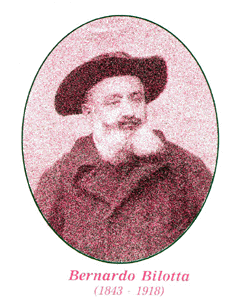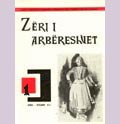 |
PAPAS BERNARDO BILOTTA (1843-1918)
One of the most famous Italo Albanian men in the cultural and patriotic area is, without doubt, papas Bernardo Bilotta. He was born in
Frascineto November 29, 1843, son of Emanuele Bilotta and Francesca Martire,
honorable parents. He studied in S. Demetrio Corone, at the School of S. Adriano,
which was for many years the place where the minds of the most illustrious of the
Arbėresh men of Calabria were moulded. At that school Bilotta studied for free,
beginning with his second year of studies, because he was very intelligent and studious.
Having been ordained a priest of the Byzantine rite in 1866, he also received a diploma
in elementary education and he taught at schools in Frascineto until 1873,
when he replaced, as parish priest of Frascineto, papas Michele Bellusci.
Bilotta was interested not only in pedagogy, philosophy and theology but also
in languages and classical and modern literature; but he nurtured his greatest love
for the Albanian language, which he called "divine". In Italian he wrote
many philological works about the Albanian language, and he published them from 1893 until
1915.
On August 9, 1898, the Italian National Academy of Science, Literature and Arts, located in Florence, honored Bilotta with a permanent member diploma. He received similar
diplomas from the Academy "Leonardo da Vinci", located in Tortona; and
from the International Partenopean Academy at Naples. He was also a member of the Committee that promoted the Albanian Linguistic Congress, at Corigliano, where he participated in October 1895,
together with De Rada, Argondizza, Camodeca, Ribecco, Lorecchio and others. At that meeting of intellectuals, Bilotta presented, with a speech in Albanian, the Albanian language
alphabet, that he was using in his writings: It was the alphabet
that he used also in the work Shpata e Skanderbekut ndė
Dibret Poshtė (The Sword of Skanderbeg at Lower Dibre).
In an Albanian poem that he read at that Congress, he asked the participants thus:
"Pay attention to study, to speak and to write this language well, to
present it renowned amidst the Languages of the World, and recommend to the
foreign intellectuals that they know how to appreciate it."
Regarding the poetic art of Bilotta, I want to point out here the opinion
of Gerolamo de Rada, who, giving him a copy of his Conference on the
"Antiquity of the Albanian Language" expresses himself thus with these words:
"To my friend and true poet, arciprete Bilotta, with a "Bravo" from the heart".
But his unprinted works written in Albanian are more numerous and important than those
already published. These were in the custody of his nephew Agostino Giordano, my father,
who gave them to me, because Bilotta had told him: "Until there is a priest
in our family, nobody must touch these".
Bilotta started his poetic-literary
activity in November 1870, with the work "Mercurio Dorsa": This satirical
work has more than 1,500 seven-syllable verses, and the Author condemns the
violent actions of an association of individuals guided by a leader of one
of the local neighborhoods. This work, which is the first in chronological order,
reveals to us the feelings of the writer, who, being a person of righteous
character, could not at all stand the injustices of men against their
brothers, particularly against the poor and the humble. This characteristic
of his style and manner of thinking, that could not stand violence and
oppression, comes out in all of his work, also in those of a religious nature.
We can thus say that Bilotta was truly a representative of the Albanian race,
with which he also shared his suffering. The very nice fantasy novel, entitled
"The thirteenth one", that has almost 2,000 eight-syllable verses, has no date,
but judging from the alphabet employed, seems to go back to the year 1870.
This work can be read in one sitting, because of the argument and because of
the fluidity of the poetry. The Author considered it very important.
The poverty of a numerous family is defeated by the ability and the good fortune of
the youngest of the thirteen brothers.
In 1874 he began the epic poem The Sword of Skanderbeg at Lower Dibre".
The three incomplete writings are from 1874, 1878 and 1888; the last complete
writing is from 1890. All these writings show us that the Author considered
this work of 12 songs, important, with more than 10,000 six and seven-syllable
verses. Ahead of the 12 songs he places an only song, in which he tells of
the duel between Skanderbeg and a giant Tartar at Adrianopolis; this song
is made up of 56 lines of six verses of six and seven-syllables, and is part of
the writing of 1874. The alphabet used in this writing is not very different from
the one used in the last copy of The Sword of Skanderbeg at Lower Dibre". Also,
the letters are very clear.
In 1888 Bilotta finished gathering 6,000 words in the language of Frascineto,
in a "Vocabulary" of nearly 200 pages. On July 18, 1891, he finished writing
the "Town History of Frascineto". This historical work is divided in 5 parts.
The fifth one is incomplete, because the narration stops at the last events
of the XVIII century. This Town History is made up of 332 lines of six
verses, that is nearly 2,000 eleven-syllable verses. The Town History is
preceded by a sonnet that begins thus:
| |
|
On a large plain, stony and luminous/
Frascineto shines at the foot of a mountain/
branch of the Apennine beautiful with flowers;/
it has water and wine and air like honey
Although this work is not well documented, it remains a source of precious information,
because they were taken from traditions of the people, to which the Arbėresh were and are always faithful.
Perhaps to complete the "Town History", Bilotta wrote the work,
"Customs of Frascineto", finished in 1894. In this work he describes
the customs, the traditions, the games, the festivals that
take place in Frascineto throughout the 12 months of the year. The
work is made of 570 triplets with 1710 eleven-syllable verses. Its value
is great because it demonstrates the love of the Arbėresh people for
national customs, taking us back to their origins or to the Albania
of Skanderbeg.
In that same manuscript, Bilotta inserts also the "Betrothal, Marriage, Birth
and Baptism", with date of May 26, 1894. Assembled, these parts make up
232 lines, with 1329 eleven-syllable verses. The historical, folkloric, psychological,
and poetic values of this work is very great, because the Author
transcribes faithfully the information, penetrating the popular sentiment
and presenting to us the simple, honest and busy life of the Arbėresh
people until the XIX century. Bilotta is embittered because the customs
are beginning to be forgotten, with the modernization of human society,
after the unification of Italy, and he says: "... but since the 60's (1860's)
people have become corrupted/ so much that every good manner is decayed and
worn out!"
One of the most voluminous works is "The Beautiful girl of the world",
which he dedicates, as a sign of esteem and friendship, to the honorable
Gentleman and famous Arbėresh poet and philologist Gerolamo de Rada,
consecrating himself to him as a most devoted disciple. This work is
an Arbėresh novel, finished on February 22, 1895, which has 440 sonnets,
with 6,160 eleven-syllable verses. It is about a young man, son of a king,
who with an enchanted horse - after he searched for and found his three
sisters, who were kidnapped by the Sun, the Sea and Hell - kidnaps the
Beauty of the World, whom he later marries with great solemnity.
Bilotta finished writing another novel on 2-16-1896, calling it "The
Beautiful Joy", made up of nearly 2,000 eleven-syllable verses. The story
is told of a king, who sends a knight to look for Beauty; but she, when
standing before the sovereign, says that she wants to marry the beloved
and valiant knight instead of the evil and lazy king, who later is killed
with boiling oil and water from Hell. In this novel, the author condemns
the pride of kings and exalts the simplicity of the oppressed.
On April 4, 1903, Bilotta starts the "Minos", a poetic-mythological work,
which has 24 songs, with more than 8,000 eleven-syllable verses. Another manuscript
of that work, with some additions, was finished on 11-3-1909, and has 37
songs with 8,664 eleven-syllable verses. But the Author changes its name
for this: "Horrible and Joyous Scenes of the Afterlife". In this work Bilotta,
drawing inspiration from Dante's "Divine Comedy", is invited by Fate to visit
the three kingdoms of the afterlife, where he learns unknown facts,
meets many important people of ancient history, and also recognizes
some of his fellow citizens of Frascineto, and he talks with them.
He began a third writing of the "Minos", very polished, on April 18, 1918,
but he leaves it unfinished at the point of song XVIII, at the end of
which he notes the date as June 8, 1918, eight days before he suddenly died.
On 9-30-1903 he finished "Hell", a poem of 10 songs, which is composed
of 3,276 eleven-syllable verses. This work seems to be the continuation
of "Minos", because it starts with these words: "I am growing tired, o my
Fate, of seeing/ the unhappy accused that are doing so badly./ Open other
doors for me, so I can see and learn/ better how the second life is".
In Hell, the Author condemns not only the criminals of antiquity, but also
his evil contemporaries. "The life of the Virgin", made of 7 songs of 1,720
five-syllable verses, was finished on May 18, 1896. On May 31 he also
finished "The Dead", where he tells about incredible and supernatural facts,
and apparitions of the dead; the 5 songs of the work are made of 2,000 eleven-syllable
verses. "The History of St. Nilo", holy Basilian monk of Rossano and founder
of the Monastery of Grottaferratta, was written to commemorate the 900th
anniversary of the death of the Saint. The work has 122 eleven-syllable sextets.
The comical drama "Don Quijote", 3,500 seven and eight-syllable verses, is from
1908. The Author tells us of the adventures of a Utopian and crazy fellow
citizen, and of his friends. On 6-26-1916 he finished another work titled
"The Life of the Madonna", made of 127 sonnets. Other 200 sonnets titled
"To the Saints that I serve in Church" are of 12-21-1917. Beyond this there
is a large amount of fables and legends, religious songs, chronicle, proverbs
and discourses, written between 1870 and 1918. These compositions are made of
more than 20,000 verses. On 12-15-1905 he finished the satire "Ignoble
Works of Unworthy People", that he had started on September 15 of the same year.
At the end of the work, the Author writes: "It has not pleased me to
use the pen to tell about the ignoble works of unworthy men in poem and story:
but I wrote them so the future generations will condemn them".
In this poetic activity Bilotta almost gathered the entire historical, folkloric and
narrative tradition of the Arbėresh people of Frascineto, and also partly of
the Arbėresh of Calabria. For this his merits related to the spilled Albanian
blood, and to Albania, were, and are, great. And his name will be remembered and
praised by all the Arbėresh and by the Mother Land, loved and never forgotten.
Emanuele papas Giordano
* * * * * * * * *
|
|



